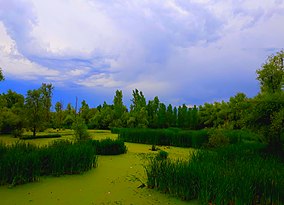Hokersar
The Hokersar is a wetland conservation area in Zainakote near Srinagar in the Indian union territory of Jammu and Kashmir. It lies in the Kashmir Valley, 10 kilometres (6.2 mi) northwest of Srinagar.[1] The Hokersar, which spreads over 1,375 hectares (13.75 km2), is a designated bird sanctuary.[2]
| Hokersar | |
|---|---|
 Hokersar wetland | |
| Location | Zainakote, Jammu and Kashmir, India |
| Nearest city | Srinagar |
| Coordinates | 34°05′42″N 74°42′27″E / 34.09500°N 74.70750°ECoordinates: 34°05′42″N 74°42′27″E / 34.09500°N 74.70750°E |
| Area | 1,375 hectares (3,400 acres) |
| Governing body | Kashmir Department of Wildlife Protection |
| Designated | 8 November 2005 |
| Reference no. | 1570[1] |
GeographyEdit
The Hokersar wetland, which is the largest bird reserve in the Kashmir Valley,[3] is situated in the Jehlum River basin.[1] It is the northernmost part of the Doodhganga catchment, at an altitude of 1,584 metres (5,197 ft) above sea level. The reserve is fed by the two perennial inlet streams; Doodhganaga from the east and Sukhnag from the west. It includes a lake and a marshy area with an average depth of 0.91 m (3 ft). In the spring, the water level rises to as much as 2.4 m (8 ft) due to runoff from snowmelt in the Pir Panjal mountain range. The wetland also acts as an absorption basin for floodwaters.[2][3]
Flora and faunaEdit
The Hokersar wetland consists of three zones with varied flora. The northeastern zone contains various dense macrophytes while Trapa natans and Phragmites australis are found predominantly in the central zone, which is a large expanse of water. The southern zone is a silted portion and acts as pasture land.[3]
The Hokersar wetland is a designated bird sanctuary. It serves as an important staging ground for medium and long distance migratory shorebirds, geese, cranes, ducks and other species that breed in the northern latitudes of Siberia and Central Asia. The Valley of Kashmir as a whole is strategically located south of the Pamirs and at the western extremity of the Himalayan range. The waterbirds fly to Kashmir Valley via the Central Asian Flyway. They begin to arrive in September–October and leave by May. Over 500,000 waterbirds were recorded in the Hokersar Wetland in 2000–01. There were seven globally threatened species among the 45 waterbird species and 66 wetland-associated bird species reported in the reserve. Northern pintail, mallard, gadwall, northern shoveller, Eurasian wigeon and common teal are the most common waterfowl, found in large numbers during the winter. Eurasian coot, red-crested pochard, greylag goose, common pochard, garganey, and ruddy shelduck are among the other species of waterbirds also found in the reserve.[2][4]
ConservationEdit
The Hokersar wetland was first designated as a conservation reserve under the Jammu and Kashmir Wildlife (Protection) Act, 1978.[3] Hokersar, Haigam and Shallabug are protected areas within the Jhelum basin and have also been declared as bird sanctuaries by the government of Jammu & Kashmir.[2] In 2005, the reserve was recognised as a wetland of international importance under the Ramsar Convention as Hokera Wetland.[1] It falls under India's National Wetlands Conservation Programme and is also included in the network of Important Bird Areas.[2]
ThreatsEdit
Threats to the Hokersar wetland include human activities and encroachments. The wetland has been reduced from 18.75 km2 (7.24 sq mi) in 1969 to 13.00 km2 (5.02 sq mi) in 2008. Over time, many areas of the wetland have been converted into paddy cultivations. Discharge of the domestic waste into the wetland, primarily through the inlet streams, has led to excessive weed growth and eutrophication, both of which pose a great threat to the reserve's flora.[3]
ReferencesEdit
- ↑ 1.0 1.1 1.2 1.3 "Hokera Wetland". Ramsar Sites Information Service. Retrieved 7 November 2020.
- ↑ 2.0 2.1 2.2 2.3 2.4 Comprehensive Management Action Plan for Wular Lake, Kashmir (PDF) (Report). Wetlands International. June 2007. Retrieved 7 November 2020.
- ↑ 3.0 3.1 3.2 3.3 3.4 Bano, Haleema; Lone, Farooq A.; Bhat, Javed I. A.; Rather, Rauoof Ahmad; Malik, Shaista; Bhat, M. Ashraf (2018). "Hokersar Wetland of Kashmir: Its Utility and Factors Responsible for its Degradation" (PDF). Plant Archives. 18 (2): 1905–1910. ISSN 0972-5210.
- ↑ "More than 3 lakh migratory birds arrive in Kashmir Valley". Buceros. 22 (2): 8–9. 2017.
